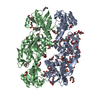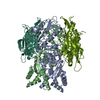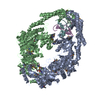[English] 日本語
 Yorodumi
Yorodumi- PDB-7ou4: The structure of MutS bound to one molecule of ATP and one molecu... -
+ Open data
Open data
- Basic information
Basic information
| Entry | Database: PDB / ID: 7ou4 | ||||||
|---|---|---|---|---|---|---|---|
| Title | The structure of MutS bound to one molecule of ATP and one molecule of ADP | ||||||
 Components Components | DNA mismatch repair protein MutS | ||||||
 Keywords Keywords |  DNA BINDING PROTEIN / DNA BINDING PROTEIN /  DNA mismatch repair protein DNA mismatch repair protein | ||||||
| Function / homology |  Function and homology information Function and homology informationadenine/cytosine mispair binding /  MutS complex / MutS complex /  mismatch repair complex / regulation of DNA recombination / mismatched DNA binding / DNA binding, bending / ATP-dependent DNA damage sensor activity / mismatch repair complex / regulation of DNA recombination / mismatched DNA binding / DNA binding, bending / ATP-dependent DNA damage sensor activity /  mismatch repair / mismatch repair /  ADP binding / damaged DNA binding ...adenine/cytosine mispair binding / ADP binding / damaged DNA binding ...adenine/cytosine mispair binding /  MutS complex / MutS complex /  mismatch repair complex / regulation of DNA recombination / mismatched DNA binding / DNA binding, bending / ATP-dependent DNA damage sensor activity / mismatch repair complex / regulation of DNA recombination / mismatched DNA binding / DNA binding, bending / ATP-dependent DNA damage sensor activity /  mismatch repair / mismatch repair /  ADP binding / damaged DNA binding / DNA damage response / ADP binding / damaged DNA binding / DNA damage response /  ATP hydrolysis activity / ATP hydrolysis activity /  ATP binding / identical protein binding / ATP binding / identical protein binding /  cytosol cytosolSimilarity search - Function | ||||||
| Biological species |   Escherichia coli (E. coli) Escherichia coli (E. coli) | ||||||
| Method |  ELECTRON MICROSCOPY / ELECTRON MICROSCOPY /  single particle reconstruction / single particle reconstruction /  cryo EM / Resolution: 3.3 Å cryo EM / Resolution: 3.3 Å | ||||||
 Authors Authors | Lamers, M.H. / Borsellini, A. / Friedhoff, P. / Kunetsky, V. | ||||||
| Funding support | European Union, 1items
| ||||||
 Citation Citation |  Journal: Nat Struct Mol Biol / Year: 2022 Journal: Nat Struct Mol Biol / Year: 2022Title: Cryogenic electron microscopy structures reveal how ATP and DNA binding in MutS coordinates sequential steps of DNA mismatch repair. Authors: Alessandro Borsellini / Vladislav Kunetsky / Peter Friedhoff / Meindert H Lamers /   Abstract: DNA mismatch repair detects and corrects mismatches introduced during DNA replication. The protein MutS scans for mismatches and coordinates the repair cascade. During this process, MutS undergoes ...DNA mismatch repair detects and corrects mismatches introduced during DNA replication. The protein MutS scans for mismatches and coordinates the repair cascade. During this process, MutS undergoes multiple conformational changes in response to ATP binding, hydrolysis and release, but how ATP induces the various MutS conformations is incompletely understood. Here we present four cryogenic electron microscopy structures of Escherichia coli MutS at sequential stages of the ATP hydrolysis cycle that reveal how ATP binding and hydrolysis induce closing and opening of the MutS dimer, respectively. Biophysical analysis demonstrates how DNA binding modulates the ATPase cycle by prevention of hydrolysis during scanning and mismatch binding, while preventing ADP release in the sliding clamp state. Nucleotide release is achieved when MutS encounters single-stranded DNA that is produced during removal of the daughter strand. The combination of ATP binding and hydrolysis and its modulation by DNA enables MutS to adopt the different conformations needed to coordinate the sequential steps of the mismatch repair cascade. | ||||||
| History |
|
- Structure visualization
Structure visualization
| Movie |
 Movie viewer Movie viewer |
|---|---|
| Structure viewer | Molecule:  Molmil Molmil Jmol/JSmol Jmol/JSmol |
- Downloads & links
Downloads & links
- Download
Download
| PDBx/mmCIF format |  7ou4.cif.gz 7ou4.cif.gz | 276.2 KB | Display |  PDBx/mmCIF format PDBx/mmCIF format |
|---|---|---|---|---|
| PDB format |  pdb7ou4.ent.gz pdb7ou4.ent.gz | 221.9 KB | Display |  PDB format PDB format |
| PDBx/mmJSON format |  7ou4.json.gz 7ou4.json.gz | Tree view |  PDBx/mmJSON format PDBx/mmJSON format | |
| Others |  Other downloads Other downloads |
-Validation report
| Arichive directory |  https://data.pdbj.org/pub/pdb/validation_reports/ou/7ou4 https://data.pdbj.org/pub/pdb/validation_reports/ou/7ou4 ftp://data.pdbj.org/pub/pdb/validation_reports/ou/7ou4 ftp://data.pdbj.org/pub/pdb/validation_reports/ou/7ou4 | HTTPS FTP |
|---|
-Related structure data
| Related structure data |  13074MC  7otoC  7ou0C  7ou2C M: map data used to model this data C: citing same article ( |
|---|---|
| Similar structure data |
- Links
Links
- Assembly
Assembly
| Deposited unit | 
|
|---|---|
| 1 |
|
- Components
Components
| #1: Protein |  Mass: 90433.234 Da / Num. of mol.: 2 Source method: isolated from a genetically manipulated source Details: ATP / Source: (gene. exp.)   Escherichia coli (E. coli) / Gene: mutS, fdv, b2733, JW2703 / Production host: Escherichia coli (E. coli) / Gene: mutS, fdv, b2733, JW2703 / Production host:   Escherichia coli (E. coli) / References: UniProt: P23909 Escherichia coli (E. coli) / References: UniProt: P23909#2: Chemical | #3: Chemical | ChemComp-ATP / |  Adenosine triphosphate Adenosine triphosphate#4: Chemical | ChemComp-ADP / |  Adenosine diphosphate Adenosine diphosphateHas ligand of interest | Y | |
|---|
-Experimental details
-Experiment
| Experiment | Method:  ELECTRON MICROSCOPY ELECTRON MICROSCOPY |
|---|---|
| EM experiment | Aggregation state: PARTICLE / 3D reconstruction method:  single particle reconstruction single particle reconstruction |
- Sample preparation
Sample preparation
| Component | Name: DNA mismatch repair protein MutS / Type: ORGANELLE OR CELLULAR COMPONENT / Details: MutS bound to two molecules of ADP / Entity ID: #1 / Source: RECOMBINANT / Type: ORGANELLE OR CELLULAR COMPONENT / Details: MutS bound to two molecules of ADP / Entity ID: #1 / Source: RECOMBINANT | ||||||||||||||||||||||||||||||
|---|---|---|---|---|---|---|---|---|---|---|---|---|---|---|---|---|---|---|---|---|---|---|---|---|---|---|---|---|---|---|---|
| Molecular weight | Value: 0.19 MDa / Experimental value: NO | ||||||||||||||||||||||||||||||
| Source (natural) | Organism:   Escherichia coli (E. coli) Escherichia coli (E. coli) | ||||||||||||||||||||||||||||||
| Source (recombinant) | Organism:   Escherichia coli 'BL21(DE3)pLysS' (bacteria) Escherichia coli 'BL21(DE3)pLysS' (bacteria) | ||||||||||||||||||||||||||||||
| Buffer solution | pH: 8.5 | ||||||||||||||||||||||||||||||
| Buffer component |
| ||||||||||||||||||||||||||||||
| Specimen | Conc.: 0.95 mg/ml / Embedding applied: NO / Shadowing applied: NO / Staining applied : NO / Vitrification applied : NO / Vitrification applied : YES : YES | ||||||||||||||||||||||||||||||
| Specimen support | Grid material: COPPER / Grid mesh size: 300 divisions/in. / Grid type: Quantifoil R1.2/1.3 | ||||||||||||||||||||||||||||||
Vitrification | Instrument: LEICA PLUNGER / Cryogen name: ETHANE / Humidity: 76 % / Chamber temperature: 277.15 K |
- Electron microscopy imaging
Electron microscopy imaging
| Experimental equipment |  Model: Titan Krios / Image courtesy: FEI Company |
|---|---|
| Microscopy | Model: FEI TITAN KRIOS |
| Electron gun | Electron source : :  FIELD EMISSION GUN / Accelerating voltage: 300 kV / Illumination mode: FLOOD BEAM FIELD EMISSION GUN / Accelerating voltage: 300 kV / Illumination mode: FLOOD BEAM |
| Electron lens | Mode: BRIGHT FIELD Bright-field microscopy / Nominal magnification: 105000 X / Nominal defocus max: 2000 nm / Nominal defocus min: 500 nm / Cs Bright-field microscopy / Nominal magnification: 105000 X / Nominal defocus max: 2000 nm / Nominal defocus min: 500 nm / Cs : 2.7 mm / Alignment procedure: COMA FREE : 2.7 mm / Alignment procedure: COMA FREE |
| Specimen holder | Cryogen: NITROGEN / Specimen holder model: FEI TITAN KRIOS AUTOGRID HOLDER |
| Image recording | Electron dose: 54 e/Å2 / Detector mode: COUNTING / Film or detector model: GATAN K3 BIOQUANTUM (6k x 4k) / Num. of real images: 4835 |
| EM imaging optics | Energyfilter name : GIF Bioquantum / Energyfilter slit width: 20 eV : GIF Bioquantum / Energyfilter slit width: 20 eV |
| Image scans | Movie frames/image: 50 / Used frames/image: 1-50 |
- Processing
Processing
| Software | Name: REFMAC / Version: 5.8.0267 / Classification: refinement | ||||||||||||||||||||||||||||||||||||
|---|---|---|---|---|---|---|---|---|---|---|---|---|---|---|---|---|---|---|---|---|---|---|---|---|---|---|---|---|---|---|---|---|---|---|---|---|---|
| EM software |
| ||||||||||||||||||||||||||||||||||||
CTF correction | Type: PHASE FLIPPING AND AMPLITUDE CORRECTION | ||||||||||||||||||||||||||||||||||||
| Particle selection | Num. of particles selected: 527979 | ||||||||||||||||||||||||||||||||||||
3D reconstruction | Resolution: 3.3 Å / Resolution method: FSC 0.143 CUT-OFF / Num. of particles: 151672 / Symmetry type: POINT | ||||||||||||||||||||||||||||||||||||
| Atomic model building | B value: 70 / Protocol: FLEXIBLE FIT / Space: RECIPROCAL | ||||||||||||||||||||||||||||||||||||
| Atomic model building | PDB-ID: 1E3M | ||||||||||||||||||||||||||||||||||||
| Refinement | Resolution: 3.2→214.02 Å / Cor.coef. Fo:Fc: 0.882
| ||||||||||||||||||||||||||||||||||||
| Displacement parameters | Biso mean: 78.874 Å2
| ||||||||||||||||||||||||||||||||||||
| LS refinement shell | Highest resolution: 3.2 Å /
|
 Movie
Movie Controller
Controller












 PDBj
PDBj






